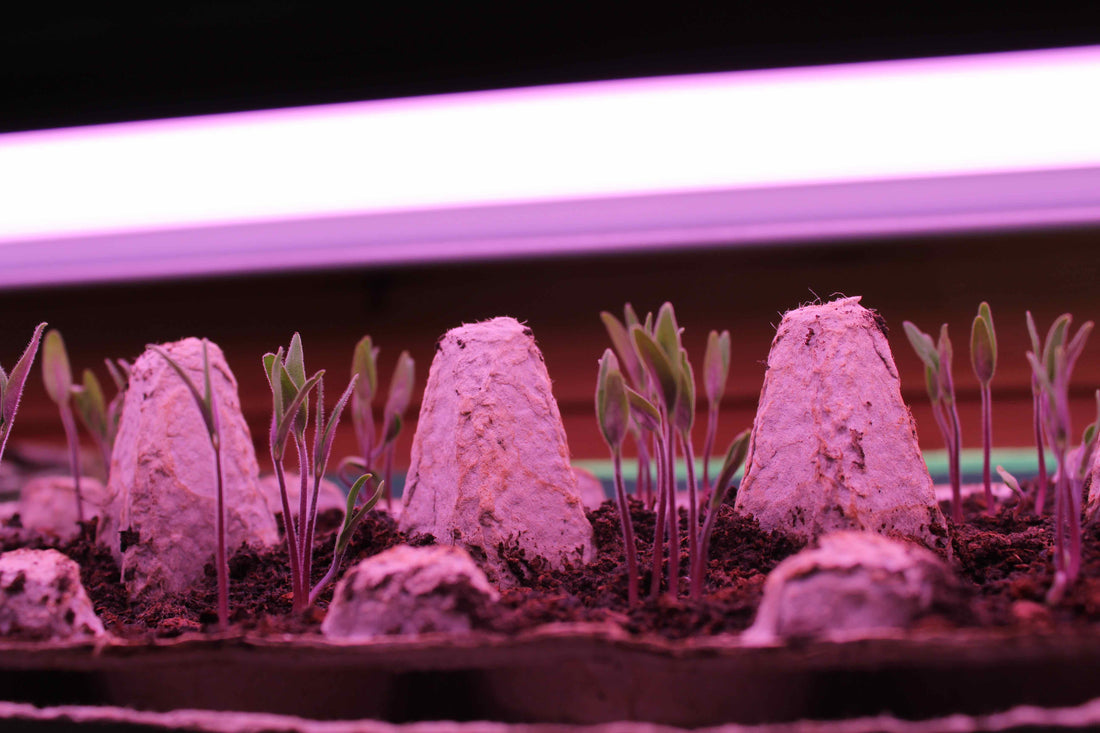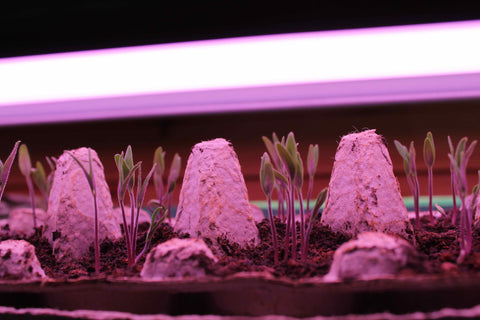
Under the Bright Lights...
Share
You've shopped for your seeds, made a seed starting plan, considered your starting trays-- Now what about lighting?
For most of us, even the sunniest window doesn't provide enough light to keep seedlings happy and healthy during the time of year we need to start our seedlings. Consider grow lights...
Why use a grow lights?
Plants need light to carry out photosynthesis, converting carbon dioxide and water into food to fuel growth. We humans need to consume a certain number of calories each day. So too with plants— plants need a certain volume of photons each day. How much varies with species and stage of growth.
Picture plants that get tall and ‘leggy’-- leaning and stretching towards a window. Without adequate light, your seedlings will get lanky and weak, struggling to produce enough food to grow into healthy plants.

Pay attention to light requirements
Plants labeled as requiring "full sun" tend to be the ones that need bright light. Supporting them with grow lights will gift you back many times over with healthier seedlings and a strong start to the gardening season. "Full sun" seedlings include most flowers and vegetable seedling, as well as warm season annuals like tomatoes and pepper plants.
If you are new to grow lights some considerations include:
- What type of plants you want to start?
- What are their light requirements?
- How many trays you are starting?
- How much space do they need?
- What shelving will you use?
- How much headroom does your shelving allow for light fixtures and plant growth?
- How many lights fixtures you will need?
- What lighting and costs does your budget allow?
Key Decisions to be made are: “Full spectrum vs. Cool blue vs. Dual Band?” and “Fluorescent vs LED Grow Lights?”
Light Frequencies— “Full Spectrum vs. Cool Blue vs. Dual Band?”
First, let’s consider the choice of light frequencies to use. Color temperature describes the color of the light frequencies produced by the grow light. It is measured on the Kelvin (K) scale from 1,000 K (warm or red) to 10,000 K (cool or blue).
The color temperature of a grow light is important because color or light frequencies affect plant growth in different ways. Blue light or 'cool blue' is necessary for vegetative growth while red light is needed to promote flowering and fruit production. The color temperature of a grow light helps you understand if the overall output of the grow light leans towards blue or red.
If you are focusing on starting plants for your garden, you would choose a full spectrum grow light with a color temperature in the blue range (5,000 - 7,000K) to promote leafy green foliage. Choose a color temperature in the red range (3,500 - 4,500K) to promote fruiting and flowering.
Let’s dive deeper— As young children we were taught the colors of the rainbow— the ROYGBIV spectrum: Red, Orange, Yellow, Green, Blue, Indigo, and Violet. That was only part of the story. There are other spectrums of light the human eye can’t see, just like there are sound frequencies the human ear can’t hear.
The spectrum of light that is absorbed by chlorophyll and is used by plants for various functions is called “photosynthetically active radiation” or PAR. Chlorophyll absorbs light from the PAR spectrum converting it into energy during photosynthesis.
There are many colors or frequencies of light in the PAR spectrum, but not all these light frequencies are visible to our eye. Each color is associated with different functions in plants. Some light frequencies or colors are more useful or efficient for various stages of plant health than others.
Our eye does not perceive red or blue light as being very bright. However, these two ranges provide the most ‘efficient’ light frequencies plant cells require to produce energy. “Dual band” grow lights take advantage of both colors, blending them for a purple or pink cast to generate ‘optimal' plant growth.

While plants primarily use blue and red light, there is research that indicates some species perform better with full spectrum light. Choosing a full spectrum light will help ensure plants have what they need. 'Full-spectrum' or 'broad spectrum' lights are closer to natural sunlight.
You may want to consider looking for those marked 6500 kelvin (k). These bulbs provide full spectrum light but leaning toward a little more blue light, to promote foliage growth.
Light Fixture— “Fluorescent vs LED Grow Lights?”
Second question to consider is, what is your preference of light fixtures— “Fluorescent vs LED Grow Lights?”

LEDs
LED grow lights are the latest trend. LED stands for light emitting diodes. Some advantages include:
- Energy efficiency— they are over 40% more energy efficient than fluorescent;
- They produce more lumens of light with less electricity;
- They are touted as having a longer lifespan; and
- Are available in more flexible shapes and sizes than fluorescent grow lights.
However, there are trade-offs. Prices for LEDs have gone down considerably in recent years but they still have higher upfront costs. Another consideration is the need to suspend LED grow lights higher above the plants than fluorescents. A 300 watt full-spectrum LED light, for instance, needs to be suspended about 54 inches above the plants to prevent a ‘burning’ effect.
When purchasing LED grow lights considerations include the spectrum of light to be used and the wattage. Remembering higher wattage may require more distance from your plants.

If you have never used LED grow lights, be prepared to experiment. You may want to start by suspending the lights higher than you think necessary and move in, watching for any negative reactions.
If you have been using fluorescent lights and would like to switch to more energy-efficient LEDs, you might consider HOT5 LED retrofit bars. These are LED bulbs that use the same connector as fluorescent bulbs, so they can pop into the same fixture!
Fluorescents
Besides being the lower cost option, fluorescent grow lights are ideal for shelving systems with limited space between shelves. The lights can be positioned much closer to the plants.
When choosing fluorescent light fixtures for grow lights find a fixture that reflects the light down onto your plants. This will maximize efficiency, enabling the plants to use more of the light for growth.
Options include:
- The traditional T-12 tube, which fits most fixtures. They are not as efficient for starting plants, but two bulbs will provide enough light for seedlings and it has the lowest upfront cost. It is best to keep the bulbs within 2" of the tops of the plants to maximize the light for the plants.
- The T-8 fluorescent tubes put out more light than the T-12 and are specifically recommended for growing plants. T-8s should be kept 2-3" above the plants.
- T-5 fluorescent bulbs are considered high-efficiency and are bright enough to replace two T-12 bulbs. These brighter bulbs should be kept a little higher above the plants, at about 5".
You guessed it-- T-5s are the most expensive, followed by T-8s with the lowest cost being T-12s. Predictably, you get what you put in!
How Bright and How Many?
As you shop for fluorescent light fixtures and bulbs, look for rating information on the number of lumens the grow light is designed to emit. This is a measure of the visible light it produces. The more lumens the brighter the light.
When shopping for energy efficient LED lights, rather than lumens, pay attention to the number of watts; the higher the wattage the more light it produces.
Seedlings that require 'full sun' need a minimum of 2,500 lumens per square foot of growing space. For example, if your shelf is 2 feet wide by 3 feet long, or the equivalent of 6 square feet-- multiply (2,500 lumens x 6 sq ft) to know that you need a minimum of 15,000 lumens per shelf. Buy your grow lights accordingly. In case math isn't your strong suit, be assured that most grow lights provide the specifications on the square footage they are designed cover.
Matching the size and dimension of the grow lights to the size and dimension of your shelving will make things easier! When considering the space required to grow transplants from seed— to seedlings— to garden-ready transplants… remember that most gardeners repot their seedlings from small seed-starting trays to larger containers at least once. The move to a larger cell size also increases the space plants will need under your grow lights!
Starting Seedlings
Seeds generally do not need light to sprout. The exception is some flowers seeds that are specifically labeled to be surface sown and 'need daylight to germinate'. However, actual daylight hours is sufficient for germination and no grow lights are required until after your seedling begin to emerge from the soil.
Be vigilant! You will want to watch carefully and provide light as soon as possible after emergence. Freshly sprouted seedlings can get 'leggy' fast!

Knowing the number of days to germination (see your seed packet information) is important. You could play it safe by turning on the lights a day or two before you expect the seedling to pop up.
Seedlings require more light than most mature plants. Once they germinate, they are developing their first true leaves and root system. To get off to a strong start seedlings require a lot of energy. They are “light hungry”. Think of a child on a growth spurt constantly saying, “I’m hungry!” Seedlings need a high volume of light energy measured in photons. Mimic a plant's natural environment, giving them 12-16 hours of light. Setting a timer will help to ensure there is a regular rhythm to their 'day' and 'night'.
Capturing and enhancing light
While most grow light fixtures are built to amplify and direct the light downward, you can help capture and bounce light back onto your plants. One method is to line either side of your shelving with white paper or some type of foil to bounce the light you are producing back to your plants. Some growth tents are specifically designed with this beneficial feature. Or you can grow in a closet with white walls.
Earlier we discussed how our human eye perceives brightness but that perception may not translate into usable photon energy for plants. Watching how your plant growth is progressing will tell you a lot in terms of how well your system is supplying the photons your plants need.
You can purchase an inexpensive light meter or even download a light meter app on your smart phone. These options measure light in lumens— a measurement of visual brightness, not the volume of usable light for photosynthesis. However, these measurements will give you a general sense of the brightness of your space.
Safety first
When purchasing your grow lights, look for UL certification to ensure the light fixture has been tested to meet electrical safety standards. Install, mount, or hang your lights securely. Follow all manufacturer's instructions. If using grow lights where they may be exposed to moisture, seek out fixtures specifically designed for those environments. Make sure they are connected to a grounded outlet.
As with any light fixture, to protect your eyes, do not look directly at the light bulbs. This is even more imperative with LED lights.
Ready to buy?
Whatever type, wattage, lumens, or spectrum you decide to buy – remember, you get what you put in… Quality matters when it comes to the grow light market. There are lots of poor quality options, particularly in the LED lighting market. You may have better results purchasing directly from a grow light supplier, rather than a common e-commerce reseller or a big box store.
Next time we will talk about seed starting soil mixes!
Our best to you,
Theresa & Dan
